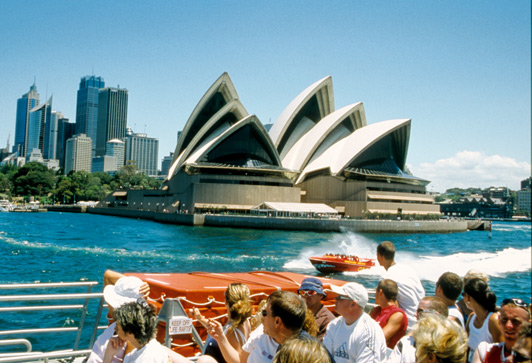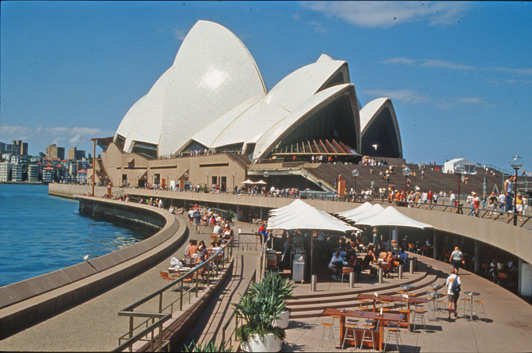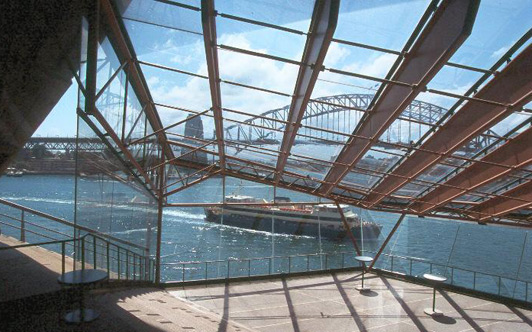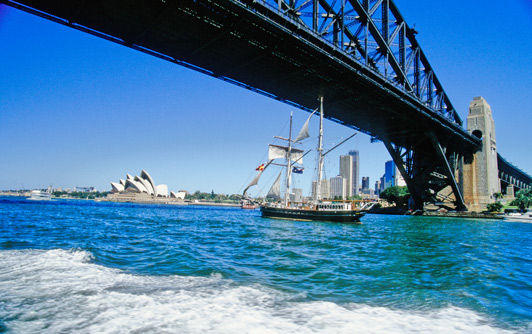Sydney Opera House – Cool Insider Info
I suggested you skip the Sydney Opera House guided tour and enjoy the site in a more authentic way, but the story of the landmark’s beginnings is part of its allure, so here’s a brief history followed by a selection of facts that even many locals don’t know:
In 1957, Danish architect Jørn Utzon won an international competition to design a “national opera house” on the edge of Sydney Harbour. His plan included a roof structure of concrete shells rising from a platform that resembled ones found in Mayan temples. Work on the site started in 1958 and was almost immediately beset with design dilemmas. Costs rose and tempers wore thin.
In 1966, Utzon’s “resignation was accepted,” a team of local architects was appointed to succeed him, and he left Australia.
The Sydney Opera House was officially opened by Queen Elizabeth II in 1973. Utzon wasn’t present and his name wasn’t mentioned at any point during the ceremony.
In 1999, the New South Wales government (the same body that had essentially fired him) asked the Danish architect to help plan a major refurbishment and partial redesign of his iconic masterpiece. He graciously agreed. Work was completed in 2004.
In 2007 the Sydney Opera House was declared a UNESCO World Heritage site.
Jørn Utzon died in 2008 having never seen the completed Sydney Opera House.
Cool facts about the Sydney Opera House:
- The Sydney Opera House isn’t an opera house per se, it’s a world-class performing arts center consisting of five performance halls, several restaurants, reception areas, archives, and hundreds of smaller rooms.
- In 1957, Utzon’s plans for a “national opera house” on Sydney Harbour were chosen over 233 other designs from 32 counties.
- Utzon had not seen the site for the opera house when he sketched his winning entry, only photos of Bennelong Point and the adjacent harbor dotted with boats. His roof shells mirrored the mainsails he saw in the pictures – building them was another matter.
- Utzon finally solved the roof dilemma by observing the way sections of an orange fit together. The roof tiles were made in Sweden.
- In 1960, American Paul Robeson – champion of the working class – sang songs of solidarity for workers on the construction site. This first unofficial concert at the Opera House left the crowd spellbound.
- The Sydney Opera House was completed ten years late and more than fourteen times over budget. The original cost estimate was A$7,000,000. The final cost was A$102,000,000.
- The Opera House didn’t cost Australian taxpayers a penny. It was paid for by 1975 entirely with funds raised in a lottery.
- The first opera performed in the newly completed Sydney Opera House was War and Peace (which seemed appropriate given the controversy surrounding the construction).
- When the Sydney Opera House opened in 1973 it lacked any kind of a parking facility, necessitating a much-maligned Opera House Park-and-Ride system that functioned for almost 20 years. Later, engineers were able to create parking underground – but it cost more – and patrons loudly mourned the loss of their offsite parking.
- More than 1,500 performances take place every year in the Sydney Opera House. These are attended by some 1.2 million people.
BTW, Australia has one of the highest skin cancer rates in the world. When you go, be sure to practice safe sun.


















WOW!
I love your clever capture of the essence and sense of place, in so few words, of this extraordinary living, breathing architectural wonder of the world. I have had the good fortune of visiting Sydney many, many times – and find myself magnetically drawn back to The House to spend a disproportionate amount of my time with Her. Sydney and environs have so much to see and do In what many say is “truly the most beautiful and exciting harbor in the world” – and The House is its crowning glory.
Thank you for sharing your many cogent insights.
Ricardo
In 1999, the NSW Government and the Sydney Opera House trust sought for reconciliation with Jorn Utzon and requested him to produce a set of design principles for further work on the building. In the year 2004, the Opera House celebrated its t birthday with the NSW premier opening up the newly refurbished Reception Hall and renamed it the Utzon Room honoring the Danish Architect Jorn Utzon. This room was the first to have authentic Utzon interior.